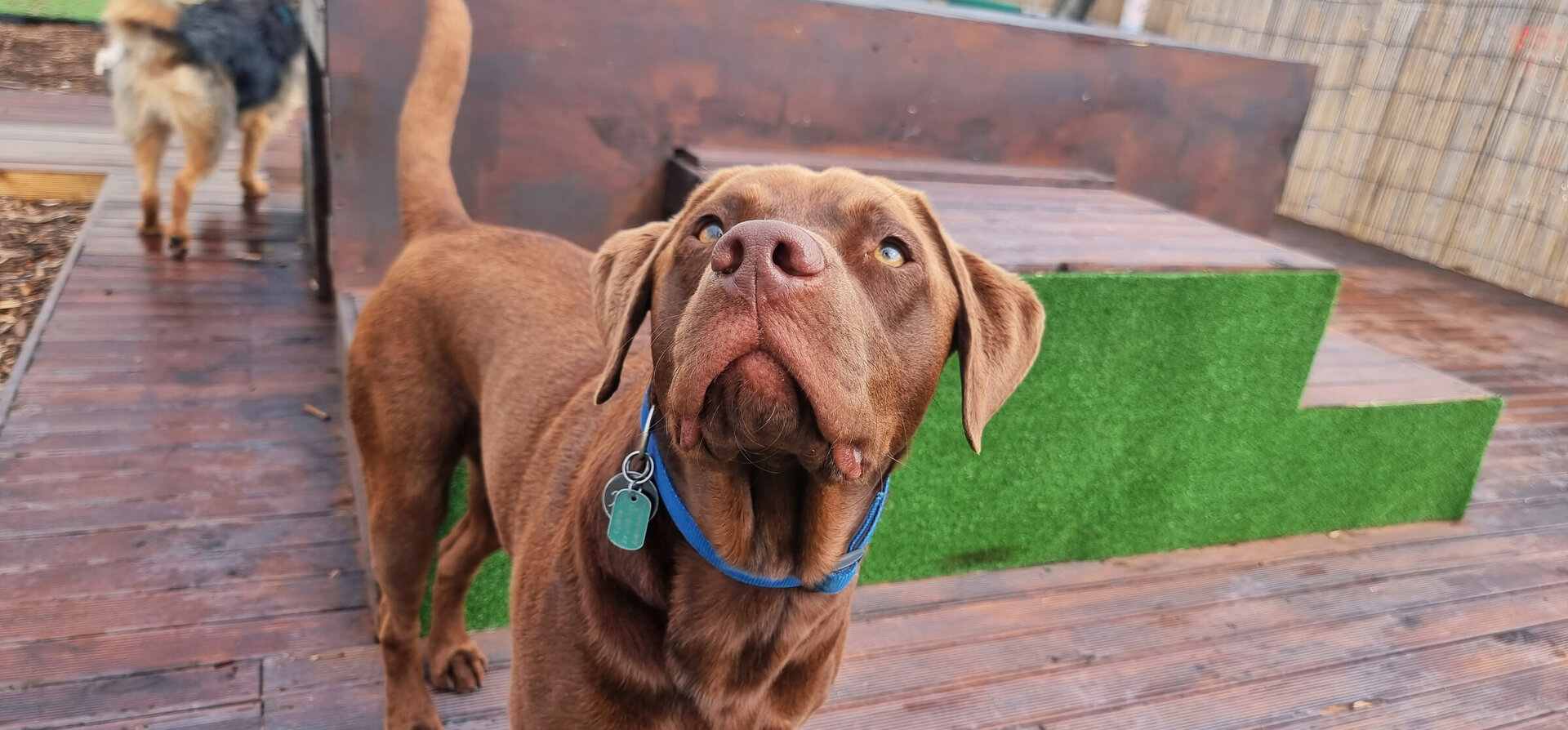What you should look for in a well-run dog daycare.
(Hint: It's definitely not the mere presence of a whole lot of dogs running around.)
Should my dog be exhausted after a day of daycare?
Many modern dog owners turn to dog daycare facilities as a source of socialization and exercise, especially in cases where dogs are otherwise home alone for the owner’s full workday.
We’ve all heard the saying, “A tired dog is a good dog,” but there’s a vast difference between a dog who sleeps because he’s tired and content, and a dog who sleeps because he’s exhausted from a stress-filled day. Dogs who spend much of their day engaged in exciting activity, such as the group play often found in poorly run daycare settings, actually experience a great deal of arousal. Arousal comes with a rush of adrenaline and cortisol, which are stress hormones. Prolonged elevated levels of stress hormones aren’t healthy – for pets or people!
DOG DAYCARE SHOULDN’T BE A FREE-FOR-ALL
It’s important to understand that all dog daycare facilities are not created equal. Generally, knowledgeable trainers agree that daycare facilities where large groups of dogs have access to free play for the majority of their visit (we’ll call those facilities “traditional daycare”), aren’t in the best interest of most dogs.
Long periods of forced social time in a large group of potentially conflicting personalities can cause a lot of tension. Large group play causes heightened arousal, even in dogs who really enjoy it. This can lead to a variety of undesirable behaviors such as mouthing, jumping, barking, humping, and even fighting.
Activities should be punctuated with structured downtime, with a goal of making sure each dog enjoys at least an hour of uninterrupted sleep during the day.
Some of the traditional dog daycares we’ve seen where, often, groups as large as 30 or more dogs spend the day in a community setting, being separated from the group only as a “time out” for exhibiting undesirable behavior. Often, proprietors of such facilities just don’t know any better.
Much like dog training, dog daycare is an unregulated industry, anyone can open a daycare. Just because someone really likes dogs, and has had dogs, does not make them qualified to oversee groups of dogs.
WHAT TO LOOK FOR
When considering dog daycare, it’s important to do your research. While we advise looking for a daycare that emphasizes enrichment over long hours spent “free ranging” with other dogs, no matter the facility, we recommend considering:
* Admissions process.
A reputable daycare should ask for background about your dog’s behavior and medical history, as well as conduct an evaluation prior to welcoming your dog into the program. It’s important to be honest when completing intake paperwork and discussing your dog. The more the facility staff knows about your dog, the better prepared they’ll be to help create a positive experience at daycare.
When it comes to accepting intact dogs, policies vary. With more pet owners leaning toward delaying spay/neuter until after 1 year of age, some daycare facilities are more flexible about welcoming intact dogs. Obviously it’s important to closely manage intact dogs in a group setting, so be sure to ask questions. How are intact dogs incorporated into a play group?
* Is daycare right for your dog?
Not all dogs enjoy the company of other dogs – especially groups of other dogs, and that’s okay! Younger dogs with an easy-going play style tend to do best in a group play setting, adult dogs who haven’t been exposed to group play are less likely to integrate successfully. This goes the same for daycares who use kennels to "cater" to dogs who would otherwise be unsuitable in social settings. The reality is that most dogs are not suitable for any kind of daycare - kennels are just used to mask this. It is said that less than 2% of all dogs are suitable for dog parks, in comparison to that my opinion is less than 0.5% of dogs are suitable for a daycare environment.
If you’re considering daycare because your dog otherwise sleeps all day and you think he’s bored, consider this: Dogs are crepuscular, meaning, they are naturally most active at dawn and dusk. It’s perfectly normal for dogs to spend much of their days asleep!
* Group size, selection, and amount of free play.
Participants for playgroups should be matched in size and play style. When it comes to group play, less is more! Dogs typically play in pairs, even when in a group setting. Watch a group of dogs. It’s pretty easy to spot which two are actively playing together, and which dogs are on the outskirts of the interaction, trying to lobby their way in.
We recommend looking for a facility that limits group size to a maximum of 10 dogs together at a time, matched based on both size and play style, with at least two knowledgeable and skilled humans overseeing the activity. Even a high-volume facility can accomplish this by rotating dogs between group playtime and rest breaks, which are key to preventing over-arousal.
Dogs need time to decompress, anything longer than an hour of group play at a time is going to be too much for most dogs. For some dogs, play lasting more than 20 to 30 minutes can begin to send them over the edge.
Areas for downtime should be completely out of view of group play to promote rest and prevent frustration behaviors. Dogs who actively ignore group interaction should have an easy way to opt out in favor of an activity better suited to their general temperament or their mood that day.
* Facility design and safety.
Play space should be free from hazards, well ventilated, and have a non-slip surface with good drainage. Messes should be cleaned immediately using an animal-safe disinfectant. Toys, bowls, and kennels should be cleaned daily.
Facilities should insist daycare participants have, at a minimum, any vaccines required by law. Dogs exhibiting signs of illness (diarrhea, vomiting, coughing, runny nose, etc.) should not be allowed to participate. The facility should have a detailed emergency plan – in writing – and be able to explain, at least briefly, how an emergency evacuation would take place.
* Staffing and staff education.
A good daycare provider should use proactive management to prevent problems and aim to set up dogs for success. If spray bottles, hoses, shake cans, citronella collars, or worse, electric collars, are the go-to on the play floor, that’s a huge red flag. A good facility will create smaller playgroups, and constantly adjust the mix of individuals in groups to keep play from spinning up into overstimulation.
The ability to set up dogs for success requires a knowledgeable staff led by a management team committed to continuing education. Ask how the staff has been educated about dog body language and behavior; the answer should include some formal learning with professional materials, not simply a number of years of experience with dogs. As you listen to the answer, pay attention: Does anyone casually throw around words like “dominant” or “stubborn?” (Those are red-flag words that would not be used in a facility committed to a dog-friendly approach.)
If a facility touts “certified” trainers, ask questions about the certification; are the courses approved by behaviour councils? There are a lot of truly awful courses around with such little or incorrect information. Do trainers rely on positive reinforcement or do they call themselves “balanced"? the latter often implies a willingness to use strong aversives, even outside of emergency situations. Make sure the facility employs enough qualified staff to ensure dogs on the group play floor are always properly supervised and never left alone.
* Too much of a good thing?
Even the most enrichment and wellness-focused daycare facility can be too much for most dogs to attend daily. No dogs do well attending daycare five days a week, especially long term. Over-socialisation is just as bad as under-socialisation, likewise, over-stimulation is just as bad as under-stimulation. Dogs need time to rest and recover from the excitement of daycare.
Facilities should be limiting daycare to a couple of days per week, with a day or two break between visits.
If you think your dog needs more interaction during the week, try looking for a dog walker who can offer your dog lower-key activities on the “off” days.
* Kennel based daycares
Some daycares use a kennel and rotate system to operate their doggy daycare in order to have more dogs to staff, and therefore have more income. Researching into how they use their kennels is vital for minimizing the risk of the environment being stressful and therefore detrimental to your dog or puppies social development.
How long are dogs in their kennel for?
Are the kennels used as a break from play, or is play a break from kennels? Time in kennels should not exceed 1 hour per rest, longer periods can cause anxiety and stress.
Are they kenneled but "out for a couple of walks during the day"?
I have worked in and seen many facilities who operate this way, for both boarding and daycare dogs. Say they're taken out for 3x walks a day - these walks are generally only 5-10 minutes long.. meaning a boarding dog is in confinement for 23.5 hours, and going to the toilet and having a sniff for around 30 minutes per day.
"But my dog comes home exhausted, they must be doing so much running and playing during their stay", yes they will, but not in a good way! Long periods of confinement are stressful to say the least, if your dog has been sitting in a heightened state of arousal with no escape, barking dogs, strange smells, being alone with their humans no where to be seen or smelt - their brains will be loaded with adrenaline and cortisol, meaning they're on high alert, unable to switch off, unable to sleep, or in shut down. Now this isn't a blanket reaction to all dogs, however only a handful of dogs are truly comfortable in this environment.
If a daycare is using a kennel system
- Ensure it is only for a couple of rest times through the day
- They do thorough and educated checks to ensure dogs are comfortable with being kenneled, they are not forced
- They have the ability to not kennel a dog if it is not appropriate for them
* Transparency
This is SO important! Your daycare should be open and honest with you every time you bring your dog in or collect them. Did they had a bad day? Were they uncomfortable? Stressed? Unsettled? Were they bullying other dogs? Mounting? Anxious? Did they make a new friend? Enjoy an activity? Did they interact? Have a good/bad training session? Do they need their days changed? Reduced? An earlier pick up? Later drop off? Were they grumpy? Tired? Happy? Independent? Did they get into a scuffle? Did they need some one on one time? Did they get startled by something?
Or do you just get told they "had a good day" every day? (I mean... does anyone have a good day every day?? I sure don't!).
This is something that is much more common than you think, staff get told to "tell the owners they had a good day" regardless as to whether they did or not - then suddenly they get a bombshell of their dog being dismissed from daycare for xyz reasons they had no idea were happening. In serious cases dogs are constantly put in situations they dont want to be in and have to consistently tell other dogs to give them space, resulting in reactivity and anti-social behaviours for you to then handle on your own (after they have happily taken your money, of course!)
* Visual Barrier Fencing
Fencing between dog areas should have fencing that has a complete visual barrier. This prevents behaviours such as barking, fence fighting (barrier reactivity), and the stress of being able to see other dogs.



